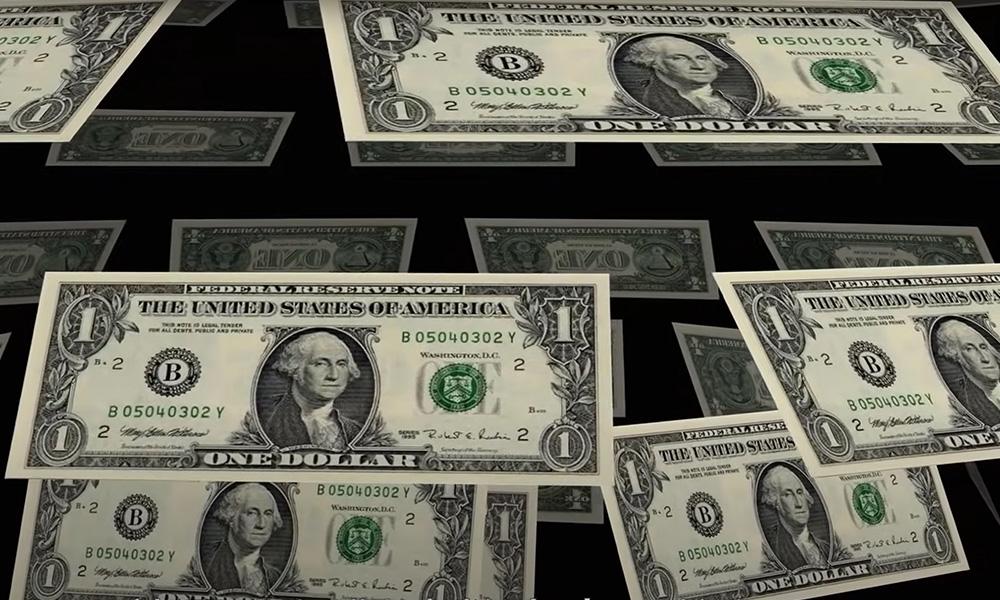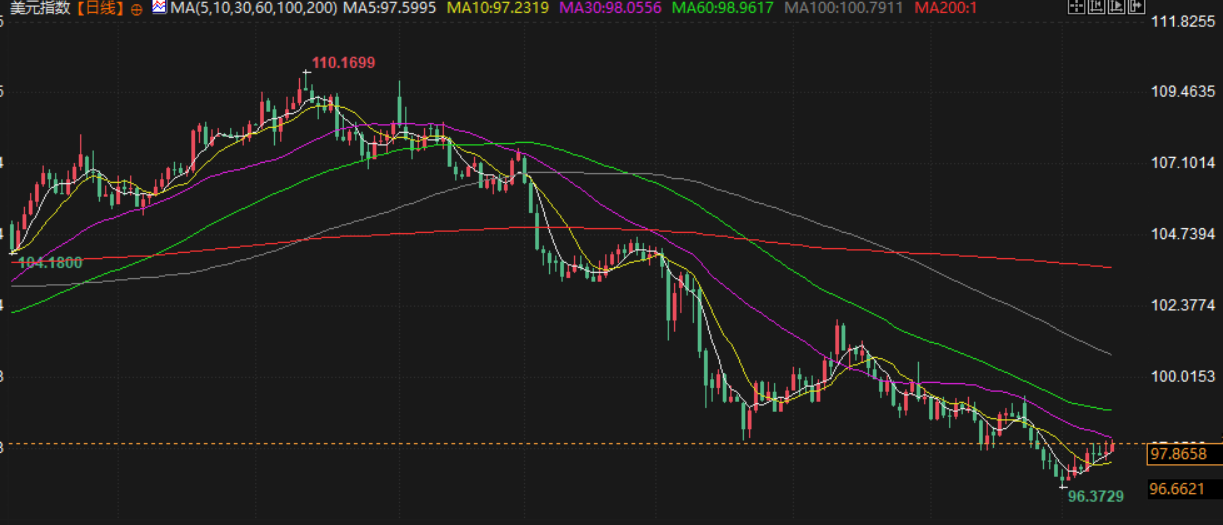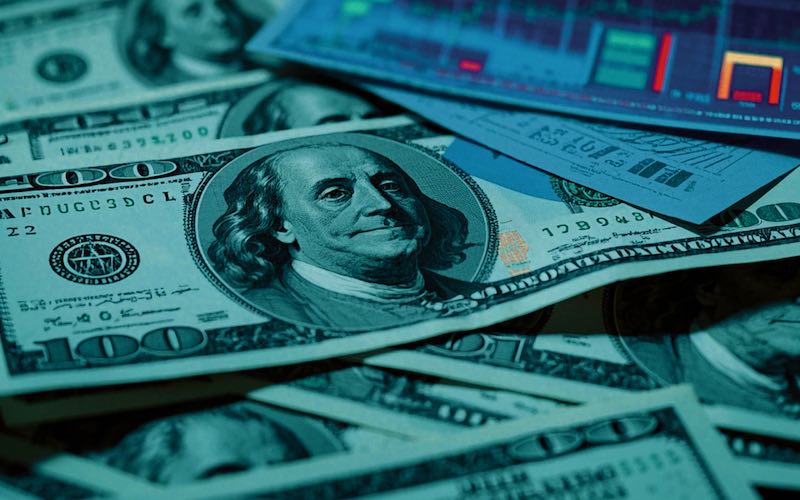The tariff storm boosted safe-haven buying, and the US dollar index rebounded on a weekly basis, ending two consecutive declines. The focus is on the G20 Finance Ministers and Central Bank Governors Meeting next week.
2025-07-12 06:56:13

On July 7, local time, Trump sent the first batch of tariff letters to 14 countries including Japan and South Korea, with tariff rates ranging from 25% to 40%. On July 9, local time, Trump sent letters to the leaders of eight countries regarding the imposition of tariffs. The eight countries include the Philippines, Brunei, Moldova, Algeria, Iraq, Libya and Sri Lanka. Among them, Libya, Iraq, Algeria and Sri Lanka will be subject to a 30% tariff, Brunei and Moldova will be subject to a 25% tariff, the Philippines will be subject to a 20% tariff, and Brazilian products will be subject to a 50% tariff. The new tariff rate will take effect from August 1.
Trump imposed a 35% tariff on Canada on July 11 and this week imposed a 50% tariff on imported copper, alerting the U.S. auto industry, which industry executives and experts said could make it harder for automakers and suppliers to absorb border taxes and rising costs.
Trump issued a letter late Thursday saying he would impose a 35% tariff on all products imported from Canada starting August 1, and the European Union is expected to receive the tariff letter on Friday.
The European Commission is said to have abandoned plans to tax digital companies, a move that marks a major victory for US President Trump and US tech giants such as Apple and Meta Platforms. Documents show that Brussels has removed the digital tax option from its seven-year fiscal plan starting in 2028 as EU-US trade negotiations enter the final sprint. Senior EU officials are in key negotiations on the budget plan, with only days left before the budget is announced.
Trump has also floated the idea of imposing across-the-board tariffs of 15% or 20% on other countries, above the current baseline rate of 10%, in a global wave of tariffs that has had a huge impact on businesses and policymakers.
“There seems to be some tariff-related jitters re-emerging following Trump’s announcement of sweeping tariffs,” said Michael Brown, market analyst at London-based online broker Pepperstone. “Overall, the moves we’ve seen in the currency market have been relatively limited, with recent ranges seemingly holding for now.”
”
The dollar rose 0.79% against the yen to 147.4 yen, up nearly 2% this week, its biggest weekly gain since early December . The dollar was flat against the Swiss franc at 0.79695 Swiss franc.
The euro fell 0.1% to $1.1688 after Trump said the European Union could receive a letter on tariff rates by Friday, raising questions about the progress of trade talks between Brussels and Washington.
The Canadian dollar fell 0.11% to 1.3672 Canadian dollars against the U.S. dollar. It fell more than 0.5% after Trump announced the tariff rate. The White House trade adviser said that the 35% tariff on Canada does not apply to goods that comply with the US-Mexico-Canada Agreement. In response to the tax letter, Canadian Prime Minister Carney said that he would firmly safeguard his country's interests, extend the Canada-U.S. negotiation period to August 1, strengthen relations with other global trading partners, and continue to cooperate with the United States in controlling fentanyl. The Canadian minister said that he is negotiating with allies such as the European Union to deal with US threats. According to the media, after Canada and the United States agreed to extend the negotiation period to August 1, Canada will not double the retaliatory tariffs on steel and aluminum to 50% on July 21 as originally planned.
The market reaction to the raft of new tariffs has been largely muted compared with the frenzied sell-off that followed the “Liberation Day” announcement in April, but investors remain nervous about the future of global trade and whether the Aug. 1 deadline is the final one.
While renewed tariff concerns have supported the dollar, some traders remain skeptical about the medium-term outlook for the greenback, which has been under intense selling pressure this year.
The dollar was also supported by data showing a resilient labor market and minutes from the Federal Reserve's latest policy meeting, which dampened market expectations for an imminent rate cut.
After Trump again urged the Fed to cut interest rates this week, he urged Powell to resign. Bill Pulte, director of the Federal Housing Finance Agency (FHFA), said on Friday that he was encouraged by reports that Federal Reserve Chairman Powell was considering resigning. I think this is the right decision for the United States and the economy will thrive.
Analyst Adam Button commented that this is a strange statement because it indicates that there are reports that Powell is considering resigning, but I can't find any reports. What is more puzzling is that Pulte has long been posting on social media that Powell should resign, and even announced this statement in advance - although the so-called "reports" cited in the statement itself are not verifiable at all. It is impossible to judge its true intentions at present, but it is worth noting that financial markets seem to have no reaction to this.
Chicago Federal Reserve Bank President Goolsbee said on Friday that the latest round of tariffs announced by U.S. President Trump has made the inflation outlook more uncertain. This may trigger new concerns about inflation, which may force the Federal Reserve to remain on the sidelines until it gets more clarity.
The latest minutes of the Federal Reserve meeting released this week showed that there were obvious differences within the Federal Open Market Committee (FOMC) on the path of interest rate cuts in 2025. Officials were divided into three factions: the mainstream expected 1-2 interest rate cuts this year but ruled out action in July, emphasizing that more economic data was needed to confirm the decline in inflation and the weak job market; the conservatives believed that the inflation risk was still high and advocated no interest rate cuts this year, paying attention to the possibility that tariff policies would push up prices; a few radicals (such as Waller and Bowman) supported an immediate interest rate cut in July, considering the inflation caused by tariffs to be controllable in the short term. The minutes showed that the FOMC unanimously decided to maintain the federal funds rate at 4.25%-4.50%. The market generally expected that the interest rate would remain unchanged at the meeting on July 30, and the probability of a rate cut in September was high. Analysis pointed out that the uncertainty of Trump's tariff policy has exacerbated the differences, and the Federal Reserve has adopted a "wait and see" strategy to closely monitor inflation and employment data.
The dollar index, which tracks the greenback against a basket of six major currencies, rose 0.28% to 97.85 and was on track for a weekly gain after two weeks of losses. So far this year, the dollar index has fallen nearly 10% on concerns that data may soon reveal more broadly the damage that U.S. policies are doing to its economy.
Sterling fell 0.54% against the dollar to hit a two-week low of $1.35050 after data showed that the UK economy unexpectedly shrank by 0.1% for the second consecutive month in May, pointing to challenges ahead for Chancellor of the Exchequer Reeves and the Labour government. The Labour government's promise to revive economic growth is central to support Reeves' spending plans. The Bank of England warned that potential growth remains weak, adding that economic activity in the first quarter was boosted by one-off factors such as adjustments to stamp duty. Previously, the Bank of England kept interest rates unchanged at 4.25% last month, but markets expect the central bank to be very likely to cut interest rates by 25 basis points at its next meeting in August.
MHA economic adviser Joe Nellis warned that the UK's GDP shrank for the second consecutive month, which is bad news for the country's chancellor, as the government needs to rely on economic growth to fund its spending plans. He said that since the ruling Labour Party is likely to oppose deep cuts in public spending and borrowing is limited by self-imposed fiscal rules, Reeves will have little choice but to raise taxes. "Whatever the chancellor decides, the increasing tax burden is unlikely to encourage economic growth."
The Australian dollar closed higher against the U.S. dollar this week after the Reserve Bank of Australia kept its policy rate unchanged at 3.85% on Tuesday, saying it needed more time to assess inflation data. Economists had expected a 25 basis point cut in rates to 3.6%.
The RBA said in its statement on Tuesday that it was awaiting "more information to confirm that inflation remains on track to reach 2.5 per cent on a sustainable basis. While the most recent monthly consumer price index (CPI) readings suggest that inflation in the June quarter was likely to be broadly in line with expectations, it was slightly above expectations."
Australia's inflation rate came in lower than expected at 2.1% in May, the lowest since October 2024. Inflation in the first quarter was 2.4%, remaining at its lowest level in four years.
Australian Treasurer Jim Chalmers said the RBA's move was "not the outcome that millions of Australians had hoped for, nor was it the outcome that markets or economists expected."
He added that Australia had made "substantial and sustained progress" in controlling inflation and praised the government's efforts to reduce the cost of living as the country struggles with slowing economic growth due to cuts in public spending, weaker consumer demand and exports.
In the first quarter of this year, Australia's economy grew by 1.3%, lower than the market expectation of 1.5%.
The New Zealand dollar closed lower against the U.S. dollar this week after the Reserve Bank of New Zealand agreed on Wednesday to keep the official cash rate unchanged at 3.25%. By mid-2025, the annual rate of CPI inflation is likely to rise to the upper limit of the Monetary Policy Committee's 1% to 3% target range.
However, headline inflation is expected to remain range-bound and return to around 2% by early 2026, supported by spare capacity in the economy and declining domestic inflationary pressures. Higher export prices and lower interest rates are supporting the recovery in the New Zealand economy. However, heightened global policy uncertainty and tariffs are expected to reduce global economic growth. This is likely to slow the pace of New Zealand's economic recovery and reduce inflationary pressures. The economic outlook remains highly uncertain. Further data on the pace of New Zealand's economic recovery, persistent inflation and the impact of tariffs will influence the future path of the Official Cash Rate. If medium-term inflationary pressures continue to ease as expected, the Board expects to reduce the Official Cash Rate further.
ING analysts said that with the release of inflation data on July 20 and employment data on August 5, pricing may change suddenly. NZD/USD is expected to have downside risks, with the target price likely to be close to 0.590 later in the summer, mainly due to rising US inflation expectations and the Fed's hawkish repricing.
Next week, the foreign exchange market will focus on speeches by several Federal Reserve officials, the Federal Reserve's Beige Book on the economy, speeches by the Bank of England Governor and Chancellor of the Exchequer, and the two-day G20 Finance Ministers and Central Bank Governors Meeting starting on Thursday (July 17-18).

- Risk Warning and Disclaimer
- The market involves risk, and trading may not be suitable for all investors. This article is for reference only and does not constitute personal investment advice, nor does it take into account certain users’ specific investment objectives, financial situation, or other needs. Any investment decisions made based on this information are at your own risk.










